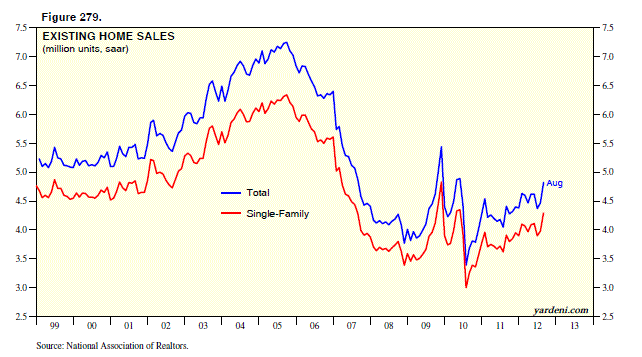 |
It was only a week ago that the Fed's FOMC formally implemented its latest and most radical version of quantitative easing on September 13. While the details surprised the markets, the concept of an open-ended QE3 was first floated by John Williams, president of the Federal Reserve Bank of San Francisco, in a July 23 interview in the FT. He is a voting member of the FOMC.
In the interview, Williams warned of significant downside risks to the US economy from the fiscal cliff, the euro zone crisis, and the global slowdown. He favored QE3 with the Fed buying mortgage-backed securities. He proposed that it be open-ended without specifying how much the Fed would purchase and when the program would end. That’s exactly what the Fed implemented last week. (I highlighted this story in our Morning Briefing the very same day it appeared in the FT.)
Williams floated the idea again in an interview reported in the 8/10 issue of the San Francisco Chronicle. When he was asked whether QE3 should be saved to cushion the fall off the cliff early next year, if necessary, he responded: "We want to position the economy to be strong in advance of that. If you are really worried about running out of ammunition, you want to act more aggressively, more quickly and better prepare yourself for that eventuality." (I believe the question was inspired by a conversation I had with the reporter who asked me what I would ask Mr. Williams.) Boston Fed President Eric Rosengren, who is a non-voting member of the FOMC, seconded Williams’ motion for open-ended QE3 in an interview reported in the 8/7 WSJ. According to the minutes of the July 31-August 1 FOMC meeting, released yesterday, "Many participants expected that such a [QE] program could provide additional support for the economic recovery both by putting downward pressure on longer-term interest rates and by contributing to easier financial conditions more broadly." On August 23, I made the following prediction about Fed Chairman Ben Bernanke’s next big speech: “I think there’s a chance that he might announce during his August 31 speech at Jackson Hole that the Fed will launch an open-ended QE3 program with the hope of turbocharging the economy so that it can leap over the cliff.” He didn’t do so explicitly, but he certainly set the stage for the FOMC decision on September 13 by expressing his “grave concern” about the unemployment problem. For quite some time, I’ve sided with the FOMC’s hawks, who have been critical of QE. I wasn’t a fan of QE2. I think it backfired, reducing the purchasing power of consumers by boosting food and fuel prices. I wasn’t rooting for QE3. There are lots of other critics of the Fed's latest unconventional easing program. However, now that it’s a done deal, I’m willing to be open-minded about open-ended QE3. As I previously noted, Bernanke & Co. were very clever to focus QE3 on purchasing mortgage-backed securities since the housing market was starting to recover without any additional assistance from the Fed. If it continues to do so, they can take credit for it! Sure enough, the latest data for new and existing home sales and for housing starts all look quite good. The most current series, available for September, are based on a monthly survey of members of the National Association of Home Builders. Their overall Housing Market Index rose this month to 40, up from 14 a year ago and the best reading since June 2006. August was a very good month for existing home sales, which jumped 7.8% m/m. If QE3 boosts US economic growth by giving the housing industry an extra lift, that would be good for earnings. If it weakens the dollar, that would be good for earnings. The JP Morgan trade-weighted dollar index was up as much as 9.3% y/y this year on July 24. It is now flat y/y. As a very rough rule of thumb for the S&P 500, I reckon that a 10% increase in the dollar will depress profits from overseas by 20% and total profits by 10%. |
Saturday, September 22, 2012
QE3: A Brief History
Subscribe to:
Post Comments (Atom)


No comments:
Post a Comment